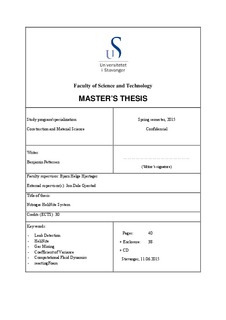| dc.contributor.author | Pettersen, Benjamin | |
| dc.date.accessioned | 2015-09-15T07:50:24Z | |
| dc.date.available | 2015-09-15T07:50:24Z | |
| dc.date.issued | 2015-06-13 | |
| dc.identifier.uri | http://hdl.handle.net/11250/299860 | |
| dc.description | Master's thesis in Structural engineering. | nb_NO |
| dc.description.abstract | In today’s leak detection market the substance HeliNite is widely used. It contains helium and nitrogen gas, and offers highly sensitive leak detection. The company Nitrogas AS has patented and constructed a nitrogen generator. During the construction process there was an idea of introducing a helium bottle to the system, which enables the generation of the substance HeliNite. Instead of acquiring prefilled
bottles, Nitrogas AS intends to offer the possibility of on-site production of HeliNite – allowing versatility and customization of leak tests. Hopefully the system will meet an unsaturated demand.
The thesis has offered a draft of the Nitrogas HeliNite system. To ensure the accuracy and repeatability of the leak test the HeliNite mix needs to be properly blended. There has been completed a thorough investigation of the requirements for a uniform gas mix.
A presentation of required components, considerations and a walkthrough of the system have been provided. Whether or not the presentation of the Nitrogas HeliNite system is successful cannot be determined until the construction and testing of the first prototype, but the proposal should have provided a solid foundation.
The investigation of the gas mixing was done in the software OpenFOAM, using the solver reactingFoam. The experiments commenced by simulations on a clean pipe, followed by stepwise increases in inlet velocity ratios and lastly baffles in the flow direction. The quantification of the mixing was done by analyzing local concentration levels of helium by calculations of the coefficient of variance (CoV). The threshold for a uniform mix was set to CoV = 0.05. The results of the simulations suggested a velocity ratio of 48.8 to ensure a uniform mix, CoV = 0.04. The introduction of one baffle gave a CoV = 0.003, while two baffles ensured a CoV = 0.007. The conducted experiments claim that a uniform gas mix can be achieved either by a velocity ratio of 48.8 or minorobstructions. | nb_NO |
| dc.language.iso | eng | nb_NO |
| dc.publisher | University of Stavanger, Norway | nb_NO |
| dc.relation.ispartofseries | Masteroppgave/UIS-TN-IKM/2015; | |
| dc.subject | HeliNite | nb_NO |
| dc.subject | Gas Mixing | nb_NO |
| dc.subject | reactingFoam | nb_NO |
| dc.subject | konstruksjonsteknikk | nb_NO |
| dc.subject | materialteknologi | nb_NO |
| dc.subject | computational fluid dynamics | nb_NO |
| dc.subject | leak detection | nb_NO |
| dc.subject | coefficient of variance | nb_NO |
| dc.title | Nitrogas HeliNite system | nb_NO |
| dc.type | Master thesis | nb_NO |
| dc.subject.nsi | VDP::Technology: 500::Building technology: 530::Construction technology: 533 | nb_NO |
